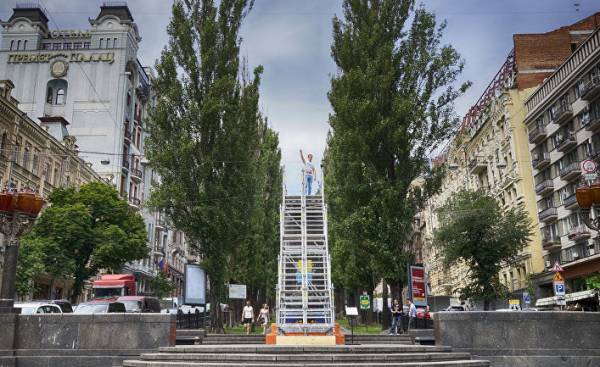
Like all post-Soviet States, Ukraine has a very complicated relationship with their Communist past. For decades throughout the country erected monuments to revolutionary figures such as Karl Marx, Friedrich Engels, and especially Vladimir Lenin. By 1991 only in Ukraine, 5 of them were 500. In some cases, until 2015 Lenin closely looked with the many pedestals in the village square and town squares, the remaining pillar of ideology in the literal sense of these words.
When the Soviet Union collapsed, and Ukraine started to understand their heritage, these statues became more than the object of worship and veneration, and the cumbersome reminder of past struggle. They started to disappear, first slowly, then EN masse in waves of the orange revolution of 2004. Finally, in 2015, the Ukrainian Parliament officially started the process of de-communization, adopted a law prohibiting these monuments, and thus began the phenomenon known as Leninabad. Since then, the statues of Lenin began to demolish on a mass scale. Today wouldn’t stand a single one.
But they have not disappeared, and the photographer Nils Ackerman (Niels Ackermann), together with journalist Sebastien Gobert (Sébastien Gobert) went in search of fallen monuments. They described the inglorious fate of the fallen idols of Ukraine in his new book, Looking for Lenin (In search of Lenin), which was released this week. Political and cultural difficulties of de-communization becomes obvious when you see the headless statue of Lenin, lying in the bushes, dressed as Darth Vader or peeking from a closet. This year marks the 100th anniversary of the Russian revolution, and there is some very strange impression when I see the lone bust of Bolshevik leader, father of the revolution and the guiding light of communism, the inglorious standing somewhere in a closet or buried under a pile of old toys, like some kind of ordinary stuff.
This project Ackerman and Gobert tried to illustrate the sinister aura that still hovers over the disgraced relics. Their photographs, combined with the eyewitness accounts add an element of the tragicomic intrigue to the debate about how Ukrainians perceive their own history, and what awaits them in the future. I recently met with them to talk about nostalgia for the Soviet era, about the relationship between architecture and power, and how is it even possible to separate the monuments of this kind from their political history.
Kim Kelly: Where did the idea for this project?
Nils Ackerman: the Project was born in the first days of the revolution of the Maidan on 8 December 2013, when protesters nationalists demolished the monument to Lenin on Bessarabska square in Central Kiev. It was the first sign of weakness of the regime, and this was the beginning of a powerful movement called “Leninabad”. Try to search this word in Google, YouTube, Twitter, and you will find there many interesting things. I was there and I saw the protesters with force to beat on the granite monument. Beat to destroy it, and even to take home a little souvenir. It was something like the destruction of the Berlin wall. But red granite (of a material made by Lenin’s mausoleum in Moscow and the tomb of Napoleon Bonaparte in Paris) proved to be very strong and chip managed only a few fragments. But the next morning there was nothing there. So we with Sebastien began the search of this statue. The case was difficult, and we this statue is not found, however, in the process of searching we managed to find many other monuments.
Sébastien Gobert: it was a way to forget about the revolution and the war that we were covering, and to approach the problems of Ukraine on the other hand. Something more interesting and less bloody. Soon we got into this seriously.
— Why did you decide to focus specifically on Ukraine?
Gaubert: Ukraine is particularly important for this project for two reasons. First, because in may 2015 the government has enacted laws on de-communization, which prohibits the glorification of Soviet symbols, as it was with Nazi symbols. Therefore, all these monuments should disappear. This brings us to the second reason. The density of the Lenin statues per square mile, Ukraine took the first place in the world, far ahead of all the others. In 1991 there were 5 500 statues, and in Russia seven thousand. But Russia is 28 times more. Today officially there is not one monument. Therefore, in our work, we decided to study the process of de-communization and find out how it is treated by residents. As it is, and what it can tell us about Ukraine.
— Pictures of some of the fallen idols seem to be absolute nonsense: the headless torso standing alone in a field, bust, peek-a-Boo from under the pile of toys. What is your approach to the process of photography?
Ackerman: My goal as a photojournalist, especially today, when we see all these scandals with fake and retouched documentary work, is to capture things as they are, without any embellishment and staging elements. I’m doing everything possible to capture powerful and beautiful moments, but nothing to add, or tweak. Very often, we even had to ask people not to touch anything when they showed the statue. It is important to show them what they are now, without cheating. To show the state of decay, oblivion, and in some cases glorification. In these monuments is something that amazes and fascinates. Once they stood in the center of large cities, and suddenly, in the blink of an eye become an annoying piece of garbage cluttering up someone’s yard. A bit like the Soviet past of Ukraine: they did not choose it, but it was.
Gaubert: Another important element of our concept is that we never make judgments. We do not say good or bad seen and heard us. It is not our story. We are foreigners, and we ought not to judge on how the Ukrainians refer to their Soviet past. It is important to show a panorama of the situation, to show the rest of the world the complexity of the problem. We may think that Lenin is reasonable to carry. But think so not all. Same with the idea to save these monuments, to preserve, to transform. In addition, the dismantling of the statue does not address a number of issues. What to do with Lenin? What’s next? How about the memory? This is the conceptual understanding of these photos and stories. To show that the issue is not yet resolved.
— What was the process of selection, how you determined which statue to look for and photograph?
Both: Every time, when I had the chance to see the statue and take a picture of it, we did it. Sometimes required long negotiations, sometimes the question was decided in five minutes. On average, one monument took one week of work. First we found by random search in Google Image. For example, we printed in Ukrainian “Lenin, warehouse” or “Ploshchad Lenina”, and then chose the most amazing and unexpected image, which only could find. So we went to articles about the demolition of monuments, and in some cases it helped us find information about them in the new location. But sometimes it was very difficult, because Lenin moves too fast for a dead man. His statues endure, rework, break, steal, sell… Sometimes we were late for a couple of days. In addition, we have developed an extensive network of acquaintances in social networks. People were interested in our work, said where there are monuments to Lenin and helped us find the right people.
Sometimes the people we met, started to talk, to tell, to scream. The General trend is that everyone in the Ukraine has something to say about Lenin. Do you pronounce the word “Lenin”, and people begin to react. When it comes to other Soviet monuments or on mosaic, people usually think for a few seconds. And as for Lenin, everyone on this account has a ready opinion. Of course, there were people doubting. Closed. During a search of Lenin area of Bessarabia, we found that it took a private collector, and took illegally. So he was very cautious, didn’t want to talk to us, although we made several attempts.
And there was a funny story in the city of Mariupol, located on the South-East of Ukraine. We knew that they have three of the monument, which was dismantled and then removed. We asked to have shown them to us. We called. We wrote letters. We went twice there. We spoke with local officials. We didn’t work out. The only answer we received from responsible for relations with the press: “We can’t allow you to look at our Lenin. Your project does not show our city and our country in a positive way”. It is connected with the ideas of Soviet aesthetics: everything must Shine and sparkle with the front part, even if inside the dust and rust. From this point of view was unacceptable for them to allow us to remove Lenin in the warehouse. But we went out and other people are really interested in the fact that all to show us. “I have Lenin, come, drink tea, and you’ll be able to take a picture!” This happened recently in Kiev.
— Interesting to think about the physical rejection of the political ideals in the form of Leninabad in the light of current debates about the dismantling of monuments to confederates here in the United States. Why do some people find it very difficult to part with these monuments?
Gaubert: First of all, there are some very strong emotional factors that go far beyond ideological beliefs. Nostalgia for better times, when the environment was safer, cleaner city where people were working when they were young. The same reaction we often see in Ukraine, where people in my life have been enormous upheavals.
But in General I would say that the relationship between architecture and power, between the monuments and the citizens it is the issue of collective consciousness, symbiosis group. During one of our presentation we asked the question: “Why do Parisians keep the name of the metro station in honor of Stalingrad, and why some streets and schools bear the name of Lenin?” It’s not a question of ideology, it is rather a question of political and intellectual views. To remember the names of some of the people who made history and contributed to the global development process. Many generations used the name of Lenin as a sign of identity, as an element of speech, as a cultural landmark. To demolish the Lenin — then remove it from the public space and of mental space. In this case, people have to build new benchmarks. This is a difficult and painful process.
— Do you feel that you can talk about the artistic value of these statues? Or their political history is too strong and does not allow them to exist in objective reality?
Ackerman: Again, one answer to this question is no. Among erected in Ukraine 5 500 monuments the majority are concrete copies made by an industrial method. They do not have great artistic value. But some, are made of more noble materials more artistic significance.
At one of our conferences on the foreground there was a curious moment. We are talking about how some of these Soviet monuments has lost its political significance. (We are basically talking about a decorative mosaic.) They were valued mainly for their beauty, their political message was perceived as quite neutral. But when we started the process of de-communization, people suddenly began to see them as examples of Soviet propaganda, because these works were created during the Soviet era. In some places these associations start to disappear, as the disappearing political significance of the monuments. Recently I was in Yekaterinburg, Russia. There is a statue of Lenin stands in the center of the city. But if you look at photos of the Central square of Ekaterinburg in Instagram, there are pictures with this giant statue one in a hundred. She’s not even marked on most maps of the city. That is, the monument stands, but none of it does. And in Ukraine, the debate has reached a special sharpness. Sometimes I have the impression that removing Lenin from their cities, the Ukrainians moved it into the center of his consciousness.







